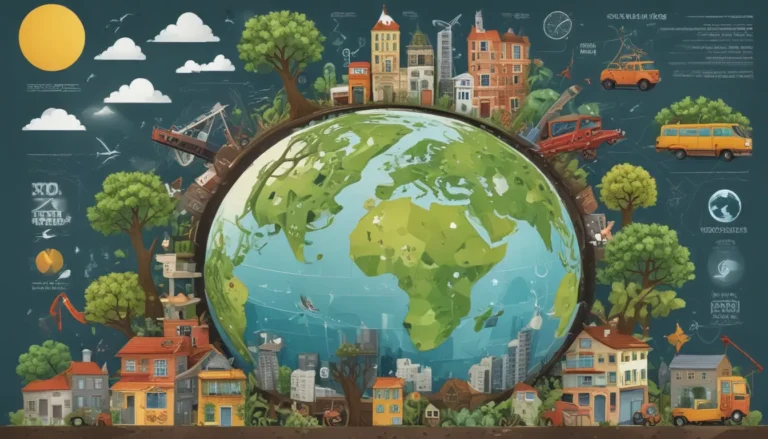A Note About Images: The images used in our articles are for illustration purposes only and may not exactly match the content. They are meant to engage readers, but the text should be relied upon for accurate information.
Are you fascinated by the intricate web of life that exists on our planet? Do you marvel at the resilience and complexity of the biosphere, the zone where life thrives? If so, you’re in for a treat! In this article, we’ll delve into 19 surprising facts about the biosphere that will enlighten and inspire you. From innovative research facilities to groundbreaking scientific discoveries, the biosphere has much to offer in terms of knowledge and wonder. Let’s embark on a journey of exploration and discovery, unraveling the mysteries of this remarkable system together.
Unveiling the Wonders of Biosphere 2
Have you ever heard of Biosphere 2? This unique research facility, located in Arizona, is a world unto itself, offering a glimpse into the complexities of ecosystems and sustainability. Here are some fascinating facts about Biosphere 2 that will leave you in awe:
- Biosphere 2 is a one-of-a-kind research facility that houses various ecosystems sealed under glass domes, providing a controlled environment for scientific study.
- Within Biosphere 2, you’ll find a 1.27-acre mini rainforest biome that mimics the conditions of a tropical rainforest, showcasing a diverse array of plant and animal species.
- Scientists at Biosphere 2 have conducted experiments to study climate change, exploring how ecosystems respond to changes in atmospheric conditions like elevated carbon dioxide levels and temperature increases.
A Journey into the World of Biosphere 2: Surprising Discoveries
Let’s delve deeper into the realm of Biosphere 2 and unravel some intriguing facts that will spark your curiosity and deepen your understanding:
- Record-Breaking Feats: Biosphere 2 boasts several Guinness World Records, including the largest fully enclosed greenhouse and the largest closed ecological system, highlighting its innovative design and scale.
- Experimental Missions: In 1991, eight individuals lived inside Biosphere 2 for two years as part of an experimental mission to simulate self-sufficient human habitation in a closed system, akin to living on another planet.
- Diverse Biomes: The facility houses a range of biomes, from deserts and savannahs to oceans with coral reefs, enabling scientists to study a broad spectrum of ecosystems and their intricate interactions.
Embracing Innovation and Education at Biosphere 2
Beyond its scientific endeavors, Biosphere 2 serves as an educational resource and a source of inspiration for eco-friendly architectural designs. Here’s a glimpse into the diverse facets of Biosphere 2:
- Educational Resource: Biosphere 2 offers valuable insights into the interconnectedness of ecosystems and environmental stewardship, making it a compelling educational destination for students and visitors.
- Architectural Inspiration: The innovative design of Biosphere 2 has inspired architects and engineers to explore new possibilities in sustainable building designs, paving the way for eco-friendly construction practices.
Unraveling the Impact of Biosphere 2 on Sustainable Practices
Through its research initiatives, Biosphere 2 has contributed to advancements in sustainable agriculture and environmental conservation. Let’s explore some notable achievements in this realm:
- Sustainable Agriculture: Scientists at Biosphere 2 have developed innovative techniques for sustainable agriculture, such as vertical farming systems and aquaponics, to address food security challenges in an environmentally friendly manner.
- Water Recycling System: The facility utilizes a sophisticated water recycling system to conserve resources and promote sustainability, exemplifying its commitment to ecological conservation.
Embracing the Future of Space Exploration: Insights from Biosphere 2
The research conducted at Biosphere 2 provides valuable insights into the challenges of long-duration space missions and the potential for self-sustaining habitats on other planets. Here’s a glimpse into the intersection of space exploration and ecological research:
- Space Exploration: By studying the dynamics of ecosystems within Biosphere 2, scientists gain insights into how self-sustaining habitats can be created for future space exploration missions, shaping the future of interplanetary exploration.
- Visitor Magnet: Biosphere 2 attracts thousands of visitors each year, offering guided tours and educational programs that highlight its groundbreaking research and environmental initiatives.
Embracing Conservation and Awareness: Biosphere 2’s Impact on Environmental Stewardship
By showcasing the intricate balance of ecosystems and the importance of environmental stewardship, Biosphere 2 raises awareness about the need to protect and preserve our planet’s biodiversity and natural resources. Let’s explore some key takeaways:
- Environmental Awareness: Biosphere 2 serves as a living laboratory that underscores the importance of biodiversity conservation and environmental stewardship, inspiring visitors to take action in preserving our planet.
- Collaborative Research: Scientists from various disciplines collaborate at Biosphere 2 to address complex environmental challenges, fostering innovative solutions and knowledge sharing.
Unveiling the Boundless Potential of Biosphere 2: A Journey of Discovery
As we reflect on the wonders of Biosphere 2 and the insights it offers into our planet’s ecosystems, let us embrace our role as responsible stewards of the environment. By appreciating the interconnectedness of all living organisms and the significance of biodiversity, we pave the way for a sustainable future for generations to come.
FAQs: Unraveling the Mysteries of the Biosphere
Curious to learn more about the biosphere and its intricate workings? Explore some frequently asked questions that shed light on this remarkable system:
-
What is the biosphere?
The biosphere refers to the zone on Earth where life exists, encompassing the atmosphere, lithosphere, and hydrosphere. -
How does the biosphere support life?
The biosphere provides essential resources like air, water, and nutrients required for organisms to survive and thrive. -
What are some examples of ecosystems within the biosphere?
Ecosystems within the biosphere include forests, grasslands, deserts, oceans, and wetlands, each supporting a diverse array of life. -
Why is biodiversity important?
Biodiversity contributes to ecosystem stability, resilience, and provides various benefits to humans, underscoring its critical role in environmental sustainability. -
How does the biosphere regulate climate?
The biosphere plays a pivotal role in climate regulation through processes like the carbon cycle, water cycle, and photosynthesis, influencing global climate patterns. -
What conservation measures can protect the biosphere?
Conservation measures include establishing protected areas, sustainable resource management, promoting renewable energy, and raising environmental awareness.
Conclusion: Embracing the Wonder of the Biosphere
In conclusion, the biosphere stands as a testament to the intricate and interconnected nature of life on our planet. From its diverse ecosystems to its vital functions, the biosphere plays a pivotal role in sustaining life as we know it. As we deepen our understanding of this complex system, let us heed the call to be conscientious stewards of our environment, safeguarding the biodiversity and natural resources that shape our world. Together, we can pave the way for a sustainable future and ensure the well-being of our planet for generations to come.
Delve into the wonders of the biosphere with us as we uncover awe-inspiring facts and insights that illuminate the beauty and complexity of our planet’s ecosystems. From groundbreaking research at Biosphere 2 to the importance of environmental conservation, there’s a wealth of knowledge waiting to be explored. Join us on this journey of discovery and appreciation for the remarkable world of the biosphere!






